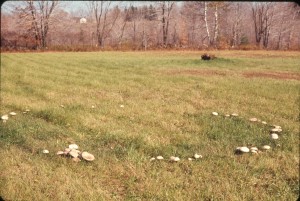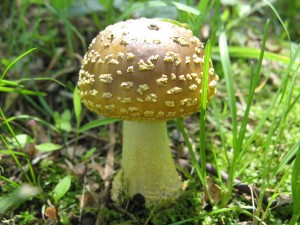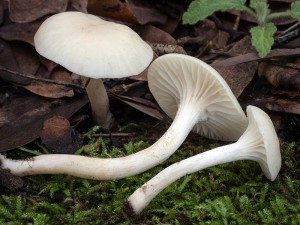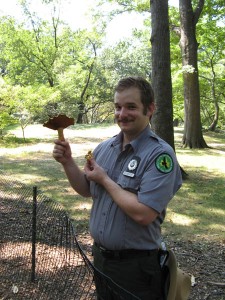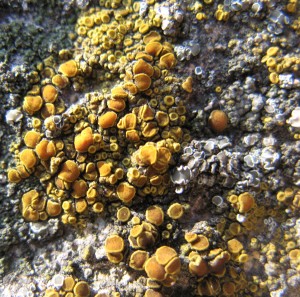CONNECTING THE DOTS: Mushrooms and Ecosystems (Lincoff 2015)
[Based on an evolving 50 image presentation given during 2015]
[Note: All references below are available for free on the Internet]
MUSHROOMS ARE THE MISSING LINK IN THE ECOSYSTEM
•1 Decomposers (and parasites) or how we first learned in school about our mushrooms……but, then, along came…..
•2 Mycorrhizae: nearly all plants have a symbiotic root association with fungi
•3 Fungal Endophytes: all plants contain fungal endophytes that help the plants survive stress
•4 Woodland Wildflowers: many “steal” carbon from nearby woodland mushrooms and store it in their roots
•5 Soil Fungi: tens of thousands of different fungi live in the rhizosphere, the top 4” or so of soil
•6 Lichens: marginal organisms or the model for life as we have come to know it?
————————————————————-
1/6…..’DECOMPOSERS”
•Once upon a time, as all good fairy tales begin,
•There were the PRODUCERS (the Plants),
•The CONSUMERS (the Animals),
•and the DECOMPOSERS………..the Fungi !
Image: Stereum ostrea – a wood decomposer
Image: Parasola (Coprinus) plicatilis – a grass & mulch decomposer
Image: Pleurotus ostreatus – a nematode killer and user of its nutrients
Image: Nematode trapped by a fungal lasso
Image: Conocybe “lactea” – a nematode killer (but not nutrient user)
————————————————————–
2/6…..MYCORRHIZAE
•Mycorrizae is a kind of mutualism in which fungi provide essential minerals in exchange for the sugars (carbon-based products) of photosynthesis.
• We know there are different kinds of mycorrhizae, root associations between fungi and plants, but there are few plants or plant groups known not to contain any mycorrhizae. And these all (?) seem to contain fungal endophytes!
DEEP MYCORRHIZAE
•More than the simple one tree – one mushroom relationship,
•We now see some trees as “hubs” furnishing younger trees of the same species with nutrients…
•AND we now see unrelated trees, even as different as a conifer (Douglas-fir) and a broad-leaved tree (birch) as sharing nutrients!
A TREE AS A “HUB” IN THE FOREST
•…the largest, oldest trees serving as hubs, much like the hub of a spoked wheel, where younger trees establish within the mycorrhizal framework of the old trees.
•….increased survival was associated with below ground transfer of carbon, nitrogen, and water from the old trees.
•….removal of hub trees could unravel the network and compromise regenerative capacity of the forests.
•http://www.botanicalgarden.ubc.ca/potd/2010/03/mycorrhizal_networks.php
Image: Douglas-fir forest in British Columbia, showing a “mother” (hub) tree surrounded by younger Douglas-fir trees.
Image: Dr. Suzanne Simard, UBC, Forestry
Image: Paper Birch and Douglas-fir: What’s the connection here?
UNIMAGINABLE A GENERATION AGO
•…Douglas-fir and paper birch trees can be linked together by species-rich mycorrhizal networks.
•…carbon transfer was enhanced when Douglas-fir seedlings were shaded in mid-summer…
•…Douglas-fir supported their birch neighbors in the spring and fall by sending back some of the this carbon when the birch was leafless.
•This back-and-forth flux of resources according to need may be one process that maintains forest diversity and stability.
•http://www.botanicalgarden.ubc.ca/potd/2010/03/mycorrhizal_networks.php
——————————————————-
3/6…..FUNGAL ENDOPHYTES
•What’s an endophyte? [“Endophytes are organisms that colonize internal plant tissues without causing apparent harm to their host.” (Arnold, E., “Hidden within our Botanical Richness, a Treasure Trove of Fungal Endophytes” - http://ag.arizona.edu/mycoherb/arnoldlab/Arnold.PlantPress.pdf)]
•What’s a fungal endophyte, and is a fungal endophyte primarily about its location in a plant or its function?
•How do we know a fungal endophyte is not a parasite in disguise?
•How do we know if what we think of as a ‘mere’ decomposer isn’t also, or primarily, a helpful endophyte?
Image: •The microbe-free plant: fact or artifact?
•Laila P. Partida-Martinez & Martin Heil
•Frontiers in Plant Science, 12/29/11
•Figure 1. The plant as the extended phenotype of endophytes. Endophytes including fungal leaf endophytes (A), bacterial leaf endophytes (B), Rhizobia (C), and arbuscular mycorrhizal fungi (D), can infect all organs of a plant, which in their presence exhibits what we usually know as its normal phenotype (left panel). These endophytes contribute so strongly to vitally important traits of the plant that a completely endophyte-free plant would suffer from chlorosis and lowered photosynthetic rates due to nutritional shortcomings, lowered resistance to abiotic stress and lowered resistance to both pathogens and herbivores and, in consequence, lowered competitive abilities and lower survival rates in nature (right panel).
Image: •The panic grass Dichanthelium lanuginosum is found in geothermal soils in Yellowstone National Park, USA, where it can grow at soil temperatures >50 °C. The plant requires a fungal endophyte, Curvularia protuberata, to survive at this temperature. In turn, the fungus requires a virus, Curvularia thermal tolerance virus (CThTV), to confer this thermotolerance effect.
Image: •“Mysterious Hygrophoraceae – mushrooms as endophytes?”
•Endophytic growth in roots of herbaceous plants has been confirmed for C. virgineus, H. coccinea, H. conica1-2. In addition, C. virgineus was found in leaves and seeds of P. lanceolata. A recent survey using Illumina MiSeq Highthroughput-Sequencing also revealed H. coccinea and H. aurantiosplendens in its surface-sterilized seeds at the Amorbach site. Furthermore, H. coccinea was also detected in pine trees and mistletoes near Regensburg (Germany) and Innsbruck (Austria).
Image: Baynes, M, et al. ‘Fungal Biologist’ 116 (2012) 133-144. “A novel plant-fungus mutualism associated with fire” …..Cheatgrass (Bromus) and the Fire Morel (Morchella “elata”)
Image: •Brassica rapa, a common weed and cultivated vegetable in the mustard family (Brassicaceae), contains an arsenal of more than 40 different species of endophytic fungi.
———————————————————
4/6…..ADULT DORMANCY AND CARBON THIEVES
•A “strategy” especially common among plants in the Blueberry Family (Ericaceae) and orchids (Orchidaceae) whereby these plants sequester fungal carbon in their roots.
•The mushrooms involved can be ectomycorrhizal, like Russula, or
•decomposers, like Coprinus s.l. or Psathyrella.
Image: Indian Pipe (Monotropa uniflora) and a red Russula species – The Indian Pipe (Ericaceae) is parasitic on the Russula that is symbiotic (ectomycorrhizal) with a tree in the Fagaceae (oak or beech)
Image: •Studies show both fungus-to-plant and plant-to-fungus carbon transfer!
•Adult dormancy indicates the continued importance of fungal carbon for the plants to thrive.
•(Adult dormancy is a condition in which mature plants lack sufficient carbon to send up shoots and flowers every year.)
———————————————————
5/6…..SOIL FUNGI
•There is an astounding diversity of unknown fungi underfoot, as diverse in a big city park as it is in an Amazonian rainforest!
•The Rhizosphere, the top 3-6” of the soil, is a true terra incognita!
Image: K.S. Ramirez et al., “Biogeographic patterns in below-ground diversity in New York City’s Central Park are similar to those observed globally,” Proceedings of the Royal Society B, 20141988, 2014.
Of the 170,000 organisms found to be living underground in Central Park, 15,000 of them are fungi, that is, Ascomycetes and Basidiomycetes! [So far, our survey of the park's mushrooms has only totaled about 400, about the same number as plant species in the park.]
[“If you want to find unique diversity and if you want to find a wide range of different below-ground organisms, you don’t have to travel around the world,” said Fierer, who is also a fellow at the Cooperative Institute for Research in Environmental Sciences. “You can walk across Central Park.”
The types of plants and animals that are able to live in a particular biome, like the desert, are largely determined by the climate. But microbes appear to be more concerned about the environment in the soil, such as the acidity and the carbon availability, than how hot or dry the climate is. This allows diverse microbial communities to thrive wherever the soil conditions are equally diverse.
“No one would ever expect to find an overlap in the types of trees we see in Central Park and the type of trees we see in a tropical forest,” Fierer said. “But that doesn’t seem to be true for the microbes living in the soil. We found all these community types just within Central Park. Below-ground biodiversity doesn’t follow the same rules as the plants and animals living above ground.”]
———————————————————-
6/6…..LICHENS
•A Lichen is a mutualistic relationship between a fungus and a green alga [or a cyanobacterium (about 10%)]. The fungus provides the housing while the alga makes food (and the cyanobacterium, sometimes just a hitch-hiker on the lichen, fixes nitrogen, an essential element for growth.)
•Almost all lichens are ascolichens, where the fungus is one of several thousand ascomycetes.
•There are a few (1%) basidiomycetes, however, that form a lichenized relationship with plants. These fungi are in the Hygrophoraceae (Lichenomphalia with a green alga, Dictyonema with a cyanobacterium).
[Question: If a lichen is a fungus with a photosynthetic “partner,” how is a plant different? Can a plant also be said to be a fungus with a photosynthetic partner?]
—————————————————-
THE TAKE-AWAY
•Economy means, literally, home management. “It’s the economy, stupid” applies to plants, which are no more independent of fungi than lichens are: the model is the community, not the individual…and…
•Plants are communities of mycorrhizal fungi in their roots, endophytic fungi in their tissues, and even epiphytic fungi on their leaves…..
•We “see” only surfaces…It’s up to us to dig deeper……and get beyond appearances.
•Fungi, once thought to be nothing more than decomposers, are now known to be the “glue” that holds everything else together, the Wood-Wide Web, the Fungal Internet of the Terrestrial World…..


